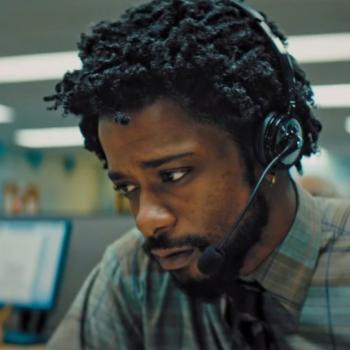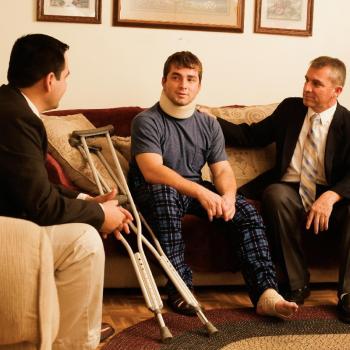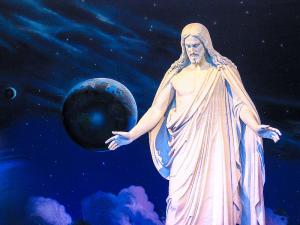Sometime at church in the past two weeks, local Mormons leaders across the country read aloud a letter addressing the Church’s response to the Supreme Court’s recent decision on same-sex marriage. [fn1] In my own ward, one person asked a question that has become more and more salient: what about gay Mormons who wish to remain Mormon?
Unfortunately, at present there are few good answers to this question. Today in my congregation, the answer given was that gay Mormons are no different than their heterosexual single compatriots, and that the advice given to the latter applies equally to the former. Other times, gay Mormons have been told to stay active and involved in church, fulfilling assignments and keeping up personal devotions. And in one painful moment several months ago, a member of the stake presidency hesitantly explained that LGB Mormons would simply be alone. (On “LGB,” see [fn2].)
LGB Mormons facing these alternately nondescript and bleak prospects have few resources to help them along. As I have found interfaith discussions to be relatively fertile ground for cultivation of new ideas, back in January I reached out to Alex Griffin and Eve Tushnet, lesbian friends of mine concerned about the place of non-heterosexuals in their respective religious traditions, Mormonism and Catholicism. Over the succeeding months, we had the following conversation via email, which I hope can be of use in fostering and ecumenical understanding of the issues of LGB members of sexually conservative faiths. I am sincerely grateful for their work and their patience.
I will present our conversation in three parts this week. The first post deals with general religious discourse about homosexuality; the second about resources our interlocutors have found enlightening, whether from within or without their faiths; and in the third, Alex and Eve will ask each other questions.
The participants (besides my periodic interjections) are:
Eve Tushnet, whose excellent book on homosexuality, celibacy, friendship, love, vocations, and more I have addressed on this blog, is a writer in Washington, DC, and blogs here on Patheos. (I met her through my equally thoughtful, likewise atheist-to-Catholic convert Yalie friend Leah Libresco, also a blogger on Patheos.) Her hobbies include sin, confession, and ecstasy. This is her first time doing an interfaith “event” with Mormons!
Alex Griffin, with whom I attended Claremont Graduate University, is working on a PhD in religious studies at Arizona State University, where she reads about gender in 19th century religion. (Ask her about the Publick Universal Friend!) She also paints her nails a lot.
To begin, what messages do you get from your church/Church about homosexuality and gay people? What areas or questions do you feel get ignored?
EVE: As with most things in the Catholic Church, the messages you hear about gay people depend on where you are. (As the old joke goes: “I’m Catholic, I don’t believe in organized religion.”) I’ve heard homilies about the courage of Gay Pride marchers and homilies about the need to fight back against the assault on marriage. I have friends who were pressured into damaging “reparative therapy” to change their orientations, and a friend who nervously came out to the young adults’ ministry only to have the rest of the ministry team encourage him to find a boyfriend!
What we don’t hear about, or rarely hear about, is openly gay Catholics seeking to live in accordance with Church teaching. I’m obviously biased since that’s where I’m at, but it’s sort of amazing to me how difficult it is to get Catholic authorities to talk about what a gay life within the Church’s teaching might look like.
There are a host of related issues which are surprisingly under-explored: What are the vocations, other than marriage and religious vows, to which God might call someone? How can the church serve as family for those who have been rejected by their families of origin, or who aren’t forming kinship bonds through marriage? What does lay celibacy (meaning “chastity for people who don’t intend/expect to marry”) look like? How can celibate people honor our bodies and sexuality, rather than just repressing our desires? And how can we support others in their vocations–our married or parenting friends, for example–and serve the next generation, “being fruitful” in ways which don’t require procreation?
ALEX: I also hear things from all sides–one of my favorite things about Eve’s book was how she mentioned that straight people who think of themselves as “progressive allies” can believe and foster just as many stereotypes, often just as damaging, as the people on the other end of the spectrum. Have two of my least favorites. One, and one of the more puzzling to hear from other Mormons, is that if I’m gay and consider myself a Mormon, I must be deluded or self-hating in some fashion. The other is that I am inherently “sooo brave” and must provide anecdotes about rescuing ignorant heterosexual Mormons from said ignorance.
Alternately, people expect me to be a spokesperson for every queer Mormon everywhere. Uma Narayan’s work on people always seeking “authentic” voices from minorities to validate their own viewpoints has been useful to me in thinking about that.
Things that are underaddressed? I have a few to list:
- Women, just generally. Anyone queer in the church has to be a dude, apparently.
- How the situation of queer Mormons both does and doesn’t map over to the issue of single people in the LDS church more broadly (i.e., nobody really knows what to do with them).
- Incredible amount of variation at the local level in terms of what’s “allowed”: everything from people attending church with their partners without it being an issue to people completely following church teaching/policy (i.e., no homosexual relationships) and still getting into trouble for merely “being” gay, despite the fact that current church policy opposes penalizing homosexual orientation.
MICHAEL: I think Eve hints at why the situation of single Mormons differs from that of gay faithful Mormons: the former can expect to marry someone, whereas the latter might not. Of course, there are some who might have success in a mixed-orientation marriage and some might find their sexuality to be fluid, but there will always be a indeterminate proportion for whom the Law of Chastity (“no sexual relations outside of heterosexual marriage”) is accompanied by an asterisk specifying that such marriage is an impossibility. At present, there is a place in Mormon culture for the marriage-seeker, but ending that search without completion is too often viewed to be willful disregard for prophetic counsel, a symptom of spiritual laziness, or unacceptable surrender to despair. If we were to forge a space for people who have a reasonable expectation of never marrying instead of subjecting them to years of encouragement and a resultant sense of failure, they might be able to integrate themselves into the community earlier and more fully.
Mormonism also needs to deal with the fact that celibate and single members lack children as well as spouses. (I like to ask: “For whom do celibate Mormons write journals?”) Given that having posterity is central to Mormon theology and culture, finding ways for such members to substantively participate in the lives of the rising generation should be just as imperative as enabling spiritual mentorship or friendship with peers. I like Eve’s expansive definition of “fruitfulness.”
Also, despite Mormonism’s historical experimentation in family structure, several things have remained constant: the only relationships formalized by saving ordinances [fn3] have been spousal and parental-filial. Even during the time of polygamy and the Law of Adoption [fn4], spousal relationships were always heterosexual; parental-filial ones were always homosocial. Formalizing other relationships would require ritual innovation.
[fn1] Discussion of local presentations of the letter and subsequent conversations can be found here.
[fn2] I use “LGB” to indicate “non-heterosexual in orientation.” I leave out the T–standing for “transgender”–because gender identity and sexual orientation are different categories, and the former is irrelevant to this particular discussion.
[fn3] A Mormon ordinance is a formal ritual; a saving ordinance is one conceived as necessary to qualify for the highest level of heaven. Sealings of both types–spouse to spouse, child to parents–are such rituals, “sealing” upon the heads of the participants the blessings of heaven.
[fn4] Until 1894, Mormons believed that one’s place in heaven was influenced by the worthiness of the person to whom one was sealed as a child; thus, if one’s father were unworthy and one nevertheless were sealed to him, one would be dragged down. To remedy this flaw of sealing parents and children in chains analogous to biological descent, Mormons believed in (but seldom practiced) the “Law of Adoption,” whereby adult men could get sealed as children to prominent LDS Church leaders, who were seen as certainly destined for the highest level of heaven. This was ended when LDS President Wilford Woodruff declared that Mormons should conduct parent-child sealings along biological lines as far as possible, setting the groundwork for modern-day Mormon’s fascination with genealogy.











